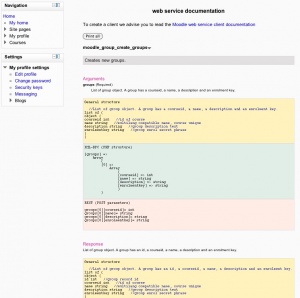Creating a web service client
Moodle 2.0
You need to know how to setup a web service first.
To see the API Documentation, connect as Admin and go to Administration > Plugins > Web services > API Documentation
Simple REST request example
To quickly test the web service works you can visit the end point from the browser or via curl. For example to call a function via REST protocol:
$ curl "https://your.site.com/webservice/rest/server.php?wstoken=...&wsfunction=...&moodlewsrestformat=json"
Customise the parameters wstoken and wsfunction to match the server side setup. Append additional parameters for the function call as needed with "¶meter_name=param", or if your parameter is an array then use "&array_name[index][parameter_name]=param". With the core_user_create_users function's (required) parameters for example:
$ curl "...&moodlewsrestformat=json&wsfunction=core_user_create_users&moodlewsrestformat=json&users[0][username]=testuser&users[0][firstname]=Anne&users[0][lastname]=Example..."
The moodlewsrestformat parameter affects the response format and can be either xml (default) or json.
Officially supported protocols
- REST
- The Moodle REST server accepts GET/POST parameters and return XML/JSON values. This server is not RESTfull.
- SOAP
- The Moodle SOAP server is based on the Zend SOAP server (itself based on the PHP SOAP server). Zend publishes a Zend SOAP client. The current server implementation doesn't fully work with Java/.Net because we didn't generated a fully describe WSDL yet. If you are working on a Java/.Net client, follow or participate to the tracker issues MDL-28988 / MDL-28989
- XML-RPC
- The Moodle XML-RPC server is based on Zend XML-RPC server. Zend also publishes a Zend XML-RPC client.
- AMF (Versions < Moodle 3.0)
- the Moodle AMF server is based on the Zend AMF server. The test client can be found in Settings blocks > Site Administration > Development > Web service test client > AMF Test client.
Demo client examples
Demo client sample codes can be downloaded on Github.
For HTML5 app creators, you can also find:
- a nice phonegap / Jquery mobile template
- a proof of concept of javascript cross-domain with Sencha Touch 1.1
Node.js apps can use the moodle-client module.
A Java Library for REST can be found on Sourceforge.
A PHP Library for REST can be found on GitHub.
A Go Library for REST can be found on GitHub.
A Python Library for REST can be found on GitHub.
How to get a user token
Moodle 2.2
Your client can call the script located in /login/token.php with a simple HTTP request. We highly recommend to do it securely with HTTPS. The required parameters are:
- username
- password
- service shortname - The service shortname is usually hardcoded in the pre-build service (db/service.php files). Moodle administrator will be able to edit shortnames for service created on the fly: MDL-29807. If you want to use the Mobile service, its shortname is moodle_mobile_app. Also useful to know, the database shortname field can be found in the table named external_services.
Request:
https://www.yourmoodle.com/login/token.php?username=USERNAME&password=PASSWORD&service=SERVICESHORTNAME
Response: (HTTP)
{token:4ed876sd87g6d8f7g89fsg6987dfh78d}
Response: (HTTPS) - Since at least M3.9
{
"token": "9859148a89546f0efe716a58e340849b",
"privatetoken": "8RpHJevJ42W7QN23OMkeYcdOYw3YfWgWGKsak7WB3Z88wcApSCVZ9TgY6M5fEO1m"
}
Difference between Moodle versions
- Moodle 2.2 and later: the script can generate user tokens for any service shortname (of course users must be allowed on the service, see How to create and enable a web service).
- Moodle 2.1: the script can only generate tokens for the official built-in mobile service. However the script can returns tokens for other services, they just need to have been previously generated.
About service shortname
At the moment a service can have a shortname if you:
- create the service as a built-in service (in db/services.php files)
- add the shortname manually in the DB. Note: we'll add the admin UI for shortname later (MDL-30229)
Text formats
Moodle 2.0 to 2.2
Moodle 2.0
HTML is the format sent/received by web service functions. All returned file urls are converted to 'http://xxxx/webservice/pluginfile.php/yyyyyyyy'
Moodle 2.3 and later
Moodle 2.3
Since Moodle 2.3 you can add few GET/POST parameters to your request (for devs who have a good knowledge of File API and format_text()):
- moodlewssettingraw => false by default. If true, the function will not apply format_text() to description/summary/textarea. The function will return the raw content from the DB.
- moodlewssettingfileurl => true by default, returned file urls are converted to 'http://xxxx/webservice/pluginfile.php/yyyyyyyy'. If false the raw file url content from the DB is returned (e.g. @@PLUGINFILE@@)
- moodlewssettingfilter => false by default. If true, the function will filter during format_text()
Moodle 3.5 and later
Moodle 3.5
- moodlewssettinglang => to force a session language for when retrieving information (same behaviour than using the language selector in the site)
